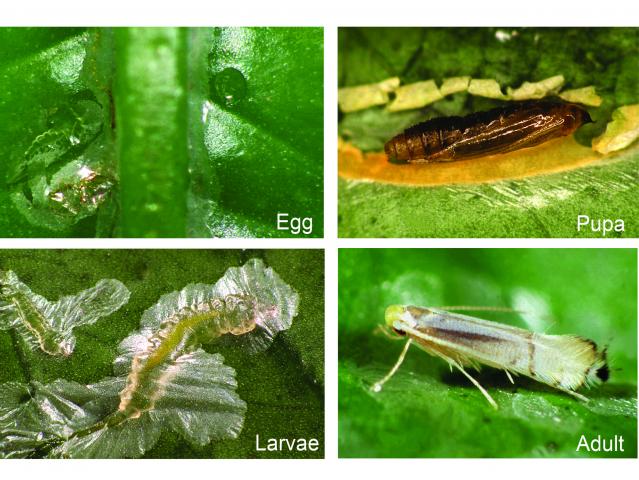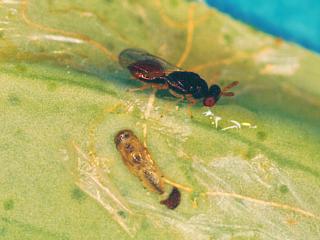Damage
- This insect attacks all citrus varieties.
- Larvae infest the young flushing foliage, producing a snake-like 'mine' as they feed. This causes the leaves to twist and curl.
- Larvae can also attack fruit and stems, though this is rarer.
- Severe infestations can retard growth of young trees. Infestations on older trees (more than five years) can cause unsightly damage, but do not normally cause significant yield losses.
- In Western Australia, attacks are most severe in late autumn peaking in April or May, depending on temperature.
- In spring, damage is minor as the leafminer population is smaller. As a result, only a small proportion of the prolific spring flush is attacked.
Life cycle
- Adults are about 2mm long, silvery-white in colour with wings fringed with long hairs. They are visible and are active in the morning and night.
- Females lay eggs singly under the leaf. Females can lay up to 50 eggs. Newly emerged leaflets (10 – 20mm) are the preferred egg laying site.
- After 2 – 10 days the larvae hatch. There are three larval stages. When they first hatch, larvae are pale-green and difficult to see. As they begin feeding, the larvae excrete their faeces into the mine forming a visible trail.
- Larvae cannot move from leaf to leaf or from lower to upper leaf surface, but remain on the same leaf throughout their life. One o eight larval mines can be found on a single leaf.
- When larvae complete their feeding (5 – 6 days in summer), they mine near the edge of the leaf causing the leaf margin to fold over. The larva moults into the fourth instar or prepupa.
- Pupation occurs in a fold on the edge of the leaf. The pupa remains in the mine until it emerges as an adult. The pupal stage lasts six days.
Monitoring and control
Monitoring
- Monitor production of significant growth flushes (more than 25% of trees flushing) on trees less than five years old. Examine at least 20 advanced shoots (those that have emerged earlier than most of the other foliage).
- Action needs to be taken if 10% of the more advanced flushes are infested by citrus leaf miner.
Sprays and cultural control
- Insecticidal control is difficult because the larvae are shielded within their mines. The pupal stage is also protected by the rolled leaf margin.
- Horticultural oil sprays reduce numbers by reducing egg lay. The tiny moths avoid surfaces sprayed with oil, so sprays should be applied before too many eggs have been laid.
- Two or more sprays may be required when new leaves are produced over an extended period.
- New growth should be protected as soon as it has formed. Once leaves have hardened, they are resistant to leafminer attack.
There are several ways to reduce infestations by limiting production of new leaves when leafminer numbers are highest:
- Prune growth flushes.
- Fertilise in late winter to promote strong spring growth when the leafminer is rarer.
- Do not overwater or overfertilise in late summer and autumn.
Biological control
Parasites
- Three of the most effective parasites in Asia (Citrostichus phyllocnistoides, Cirrospilus quadristriatus and Ageniaspis citricola) were introduced into Queensland in the 1990s. These were then released into Western Australia from Queensland. Only one, Cirrospilus quadristriatus, appears to have established in southern WA.
- A native wasp, Semielacher petiolatus, is also found in WA. Both species attack the larva, leaving distinct pupal cases.
- Parasitism levels are low – usually less than 5% of all larvae appear to be attacked in WA. In Queensland the introduced wasps can parasitise up to 90% of citrus leafminer larvae.
Predators
- Generalist predators feed on citrus leafminer. These include green and brown lacewings.



